Shortly after releasing its very first mountain bike suspension fork, the Helm, US brand Cane Creek brought out a coil-sprung version. And having amassed no fewer than 7 months of test time aboard this long travel, coil-sprung fork, David Hayward is ready to deliver his review. Over to David!
The last time I rode a coil fork was a 2012 Marzocchi. At the time, it was burly and plush. Compared to what we’re riding now though, it wasn’t great – it only had one rather soft spring weight available and, unless you rode with your weight back, would plummet through all 160mm of its travel very quickly. A year later the new Pike came along, and single crown coil forks seemed to fall out of fashion.
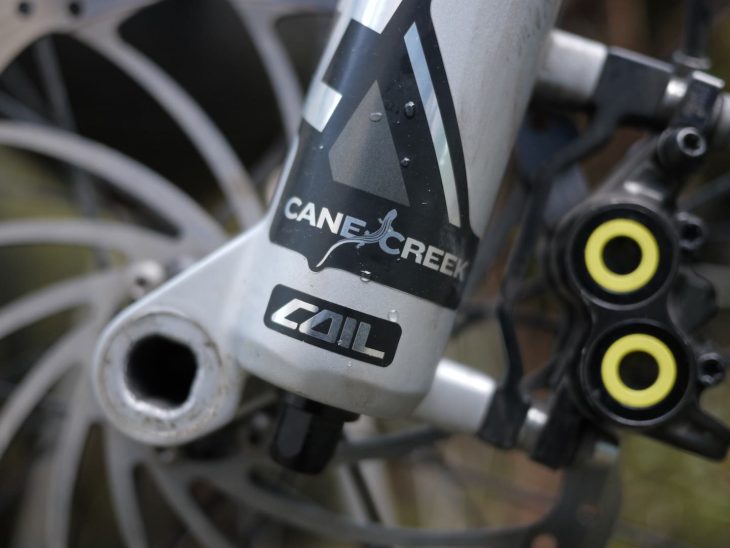
Fast forward to 2018, and this Cane Creek Helm Coil lands at the office. After such leaps and bounds in air suspension (negative springs! Volume spacers! Aftermarket innards!), I was a little sceptical, but having reviewed the air version of the same fork, knew Cane Creek were unlikely to push an unrefined fork out.
Why coil instead of air? Well for a start, it’s simpler and requires fewer seals than an air spring. That equals less maintenance and smoother performance that is more consistent throughout the range of travel.
The downsides? A coil spring is heavier and also less tuneable than air, so you have to physically swap springs for different rider weights. The linear nature of a coil spring also means you don’t get the same progressive end-stroke that you can get with an air spring. This may be good or bad depending on your preferences and riding style.
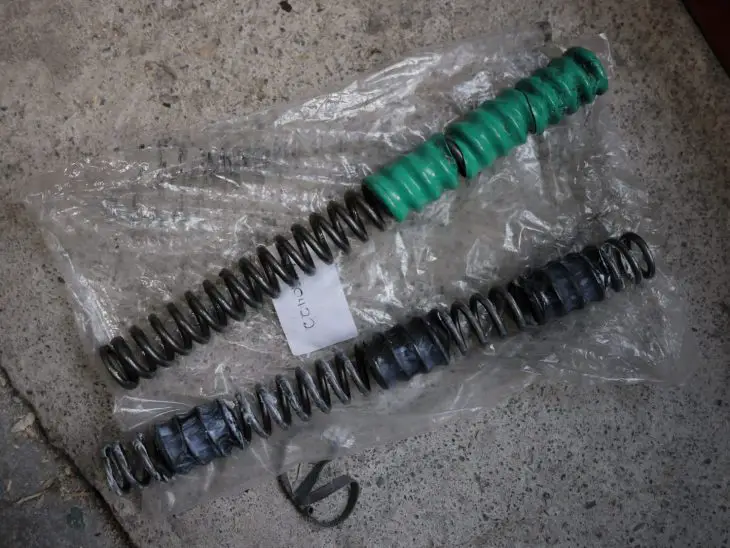
One of the more nuanced proclaimed benefits of coil suspension is that it works more consistently at different altitudes by eliminating relative air pressure differences. Moving on to coils then also opens up the delightful Pandora’s box of spring physics and preload.
I’m not really going to go deeply into the physics of either. Firstly, because I might get it wrong. Secondly, even if I got it all 100% right, having to then still debate it all at length is objectively no fun. I would rather fly an aeroplane on a treadmill, or explain the Monty Hall problem to a goldfish.
Springs make bike go good. Me talk about fork now.
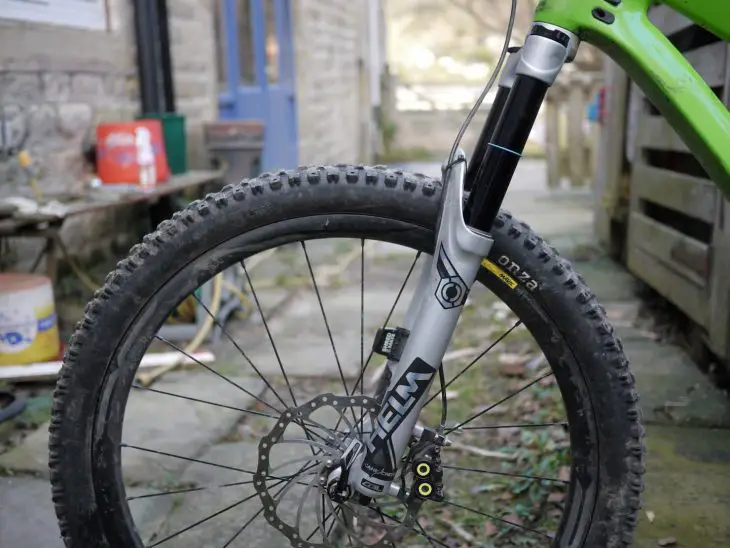
Cane Creek Helm Coil Specifications
The Helm Coil is based on the same chassis as the Helm Air, with 35mm stanchions and up to 160mm travel. Travel can be reduced in 10mm increments down to 130mm.
At 2250g, compared to the air version, the Helm Coil adds 200 grams in weight, makes some changes to the travel adjust procedure, and has exactly the same damper assembly. Cane Creek has some good video documentation and a well written manual to download too.
There are four different spring weights available, which are red (35lb, for riders 40 – 54Kg), black (45lb, for riders 54 – 72Kg), green (55lb, for riders 72 – 90Kg), and blue (65lb, for riders 90 – 108Kg). The factory default is the green 55lb spring.
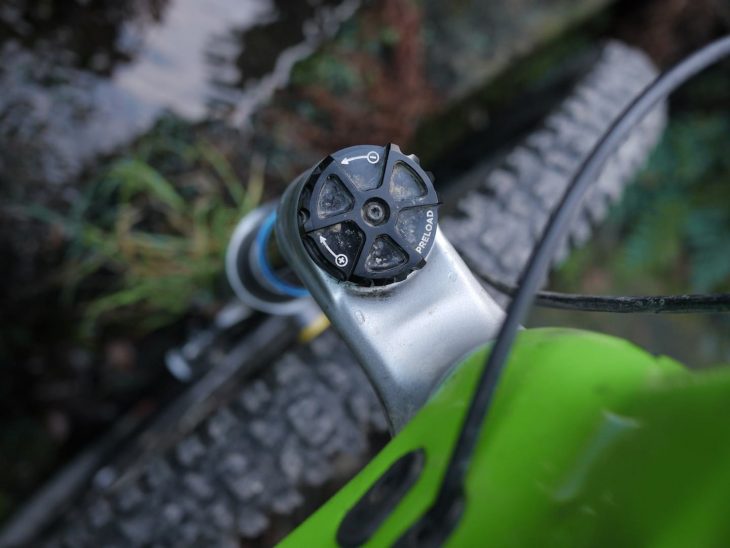
Because I was right on the boundary of the 55lb and 45lb springs, I got Extra UK to send a 45lb one over to try out too. Changing the spring takes less than ten minutes and requires minimal tools – though one is a 30mm spanner, which you might not have just lying around. Simply back off any preload, remove the preload adjuster, then remove the cap below it. Pull your old spring out, grease the new one, drop it in and reassemble with some threadlock. Very easy, and the only really tiny part is the screw to retain the preload adjuster. No springs or small ball bearing detents to lose.
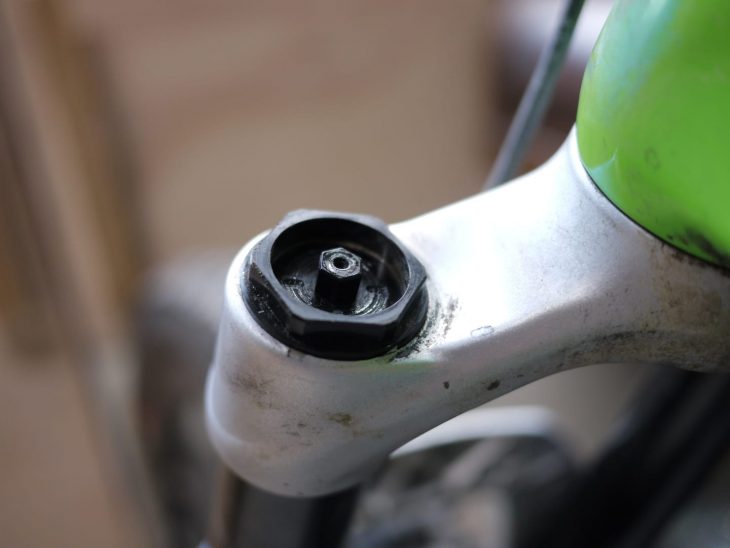
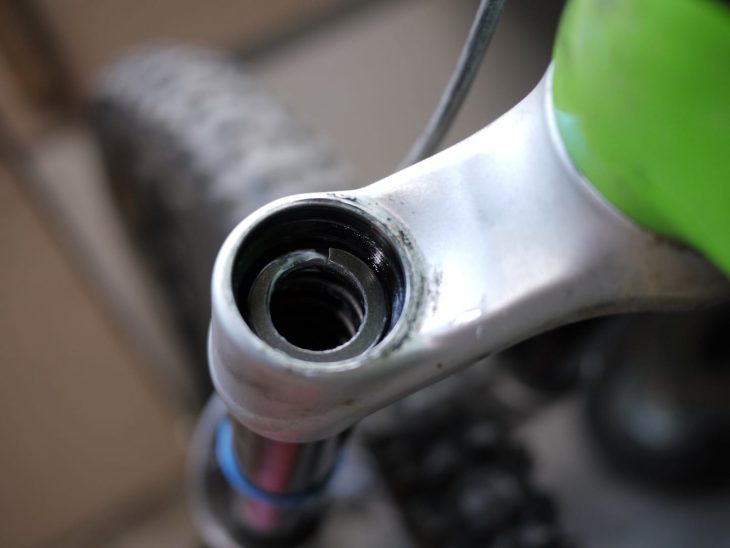
Adjustments are preload on the left fork leg, then rebound, high and low-speed compression on the right. I’m trying not to repeat things from my review of the Helm Air, but this of course has the same D-Loc axle system, which I really like and is one of the more intuitive patent-avoiding axles out there.
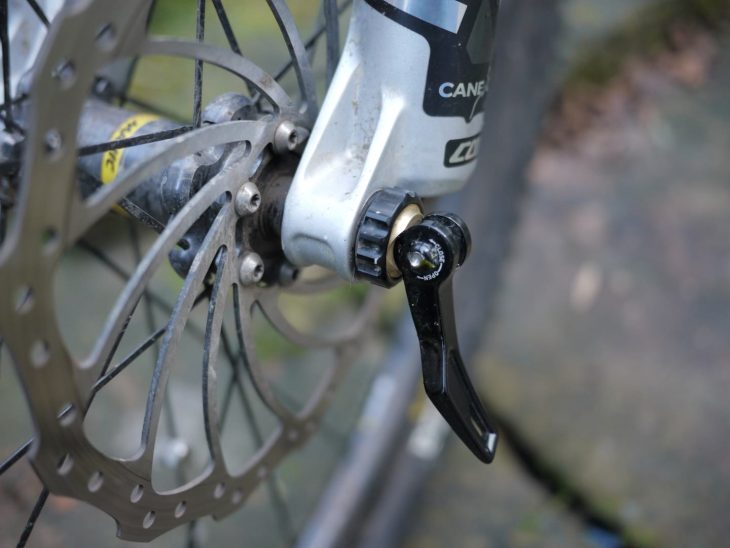

Setting Up
This has to be one of the simplest fork setups I’ve ever done. Because I’d already reviewed the Helm Air, and this has an identical damper, I just transferred my rebound and compression settings over (LSC and HSC wide open all the time – a little more on that in the Helm Air review).
Rebound damping was the one thing I did tinker with more depending on conditions and how fast I seemed to be riding in a given week, typically running 6 – 8 clicks from full slow. Beyond that, it’s a big metal spring. No messing with air pressures or equalising a negative air chamber.
These came set to 160mm, they went straight on the bike and I didn’t have to do the travel change. Much like the air volume adjustment in the air Helm, it relies on a mechanically similar spacer arrangement.
One thing to note: if you keep the lowers face down while pulling the uppers out, you can do the travel change without losing any oil. No need to drain or refill. I cannot overstate how much I love this bit of design, after previously dicking around with footnuts on other forks while simultaneously trying to aim the oil at takeaway food containers. Cane Creek has got this neat and clean.
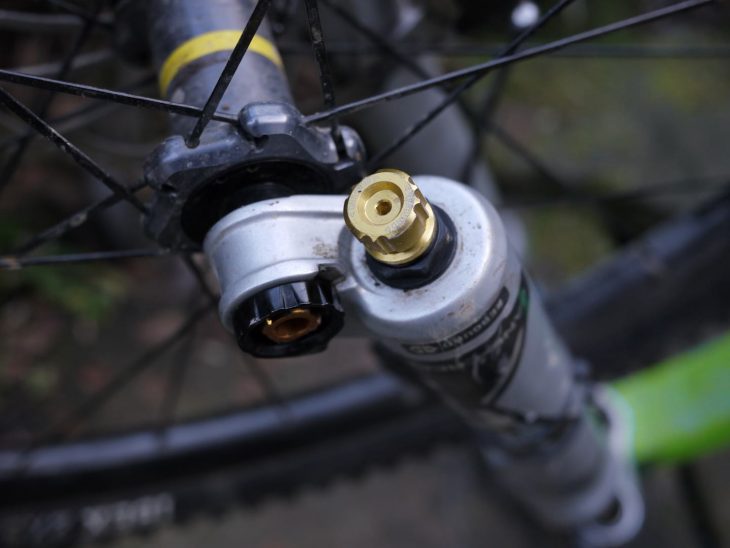
On The Trail
For most of the time I had these, I ended up on the 55lb spring running no more than two clicks of preload. Initial travel is very smooth, and the stiffer spring gave me much better support than the lighter one with increased preload. That said, the lighter spring would suit a different riding style.
At first, I thought it felt kind of harsh, but quickly realised that was just unexpected progressivity for a coil. Initial travel is smooth, but further in gets a lot firmer. It wasn’t harshness – it seemed I was just noticing the mid-travel and not the smaller bumps.
I swapped to the lighter spring to make sure though. It quickly became apparent that the 45lb spring was too light for my riding style and weight, with the fork suddenly much more eager to eat travel. It was super smooth for mellow trail riding, but as soon as I hit anything harsh, big or techy it could feel out of its depth.
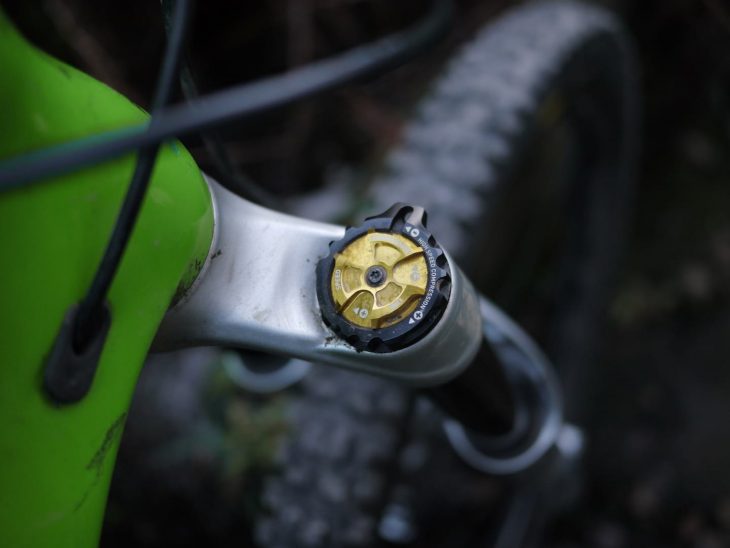
So back to the 55lb spring, which again felt super progressive. The thing is, both coil springs are entirely linear in nature, which means Cane Creek is doing something clever with the high-speed compression to make a coil fork work like this. Overall, it produces a very similar feel to the Helm Air, but in more of a fit-and-forget package than one aimed at fettlers (and fettle you can with the Helm Air).
I did play with the compression settings out of a sense of obligation, but the fork is so supportive that even wide open, it was just goading me to go faster. I left them like that for the rest of the test. Despite that, it also gave enough support on climbs, and even when standing up the bob wasn’t horrendous.
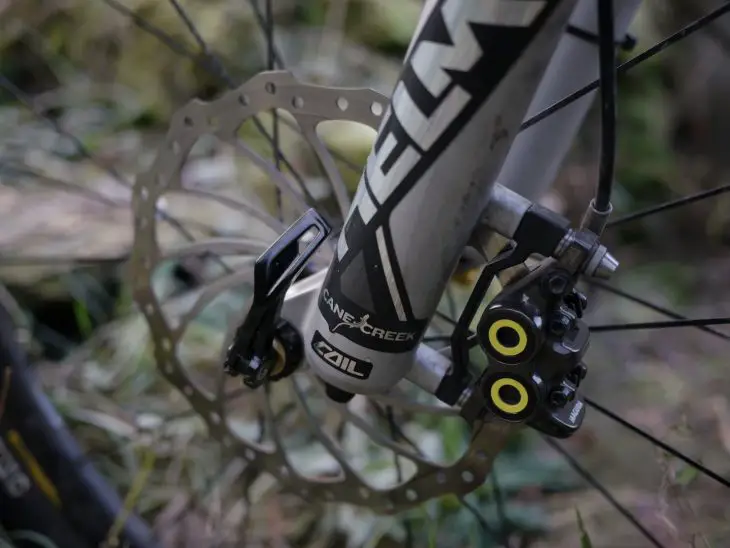
If you often tinker with your fork settings to bottom it out on every ride, the Helm Coil might frustrate you a little. Even on some of the rockier local trails, as well as an alpine bike park for a week in the summer, it mostly left a little bit of travel unused. Only when I did my best dead sailor down some bigger drops and tabletops did it start to bottom out occasionally, and even then, the progressivity meant I rarely noticed.
One other thing worth mentioning: this year I challenged myself to get used to steeper trails, and ended up on one with an average gradient of -33%, peaking at -75% for short sections. Suffice to say I was on the brakes quite a bit for that, and despite the soft initial travel, the Helm Coil didn’t bob or dive noticeably. There was just competent support all the way.
It doesn’t have many negatives. The bolt on brake hose guide rattled off on the first ride – I should have threadlocked it. The clicks in the preload adjuster are soft and quiet, sometimes making them hard to detect through a glove.
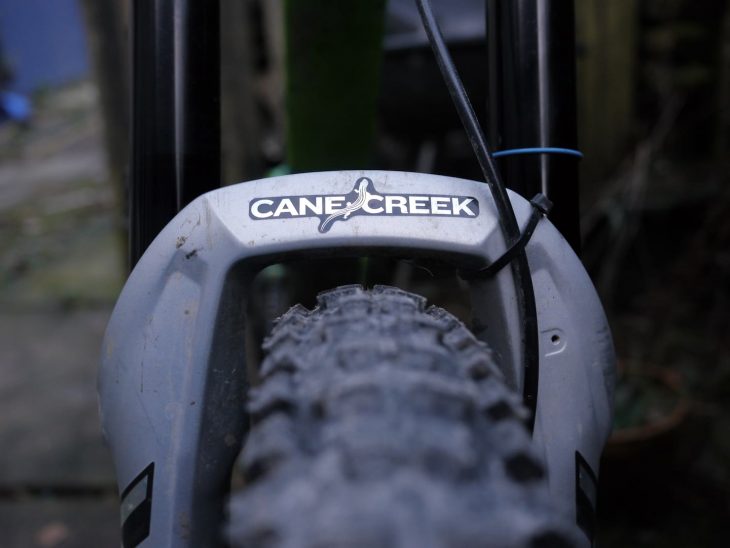
Overall, the progressive ramp of the Helm Coil doesn’t quite correspond to my ideal spring curve in an air fork. It was well within me to get the best out of it though. Much like the Helm Air before it, this is a firm fork that encourages riding progression and speed. Because of that, it’s not for everyone, and is unlikely to outstrip Fox’ or SRAM’s OEM sales. Given the brands currently shipping with them (Cotic, BTR, Swarf and Sick, off the top of my head) I don’t think that scale is what Cane Creek is going for though.
So, Helm Coil Or Air?
The weight gain in the coil is less than most shock pumps weigh, and since I’d usually carry one, that 200g is much of a muchness. The supple initial travel of the coil is nice, but you can also overfill the negative chamber in the Helm Air to aggressively reduce stiction.
They’re very close, and the choice comes down to what I normally ride. At home in Calderdale, or for a general do-it-all fork, I’d usually pick the Helm Air. That’s because at heart I’m a fettler and love to tinker with settings, adding or taking 2.5PSI here and there, always wondering if I’m getting the most out of something. For a bike park in France though, I loved the Helm Coil. Its simple, almost fit-and-forget nature really focussed me on doing as much riding as I could that week.
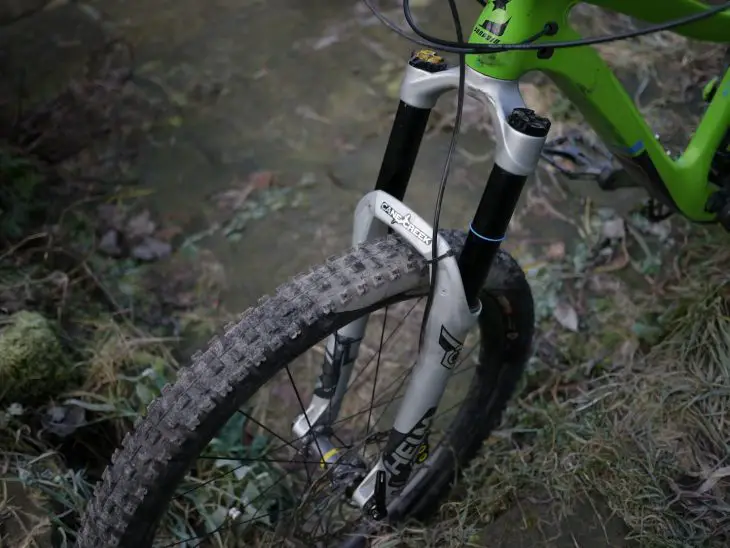
Overall
Now I’m not about to convert all my air forks to coil, but Cane Creek has converted me. If you’d asked me in 2012, I wouldn’t have thought anyone would ever get this performance out of a metal spring. While I don’t think this fork is for everyone, four spring weights do still create options. Once set up, it’s done and you barely need to touch or worry about anything – just let off the brakes and ride fast.
Review Info
| Brand: | Cane Creek |
| Product: | Helm Coil |
| From: | Extra UK, extrauk.co.uk |
| Price: | £899 |
| Tested: | by David Hayward for 7 months |
Comments (10)
Leave Reply
Post Comment

I hope CC do a 180mm coil soon and even dual crown for dh
Check out the MRP Bartlett for a dual crown, slightly lower travel, fork. I’ll be getting a Helm or Ribbon Coil in the coming months. Yum yum!
Are the UK not getting the much advertised price drop which the USA are?
Cane Creek have recouped the development cost on the fork now so dropped the price in the US.
Great review.
This sounds EXACTLY what i need for my Five.
Are the fat boy 65lbs springs readily available ? And approx £££ ?
But don’t forget the fleabay price showning (£661) needs £58 adding for postage. So really £720. Still lower than MRP or WiggleReaction.
Ohh… and that’s from the USofA so there could be a wedge of import tax and VAT to go on top. So maybe not so good really via FleaBay.
The D-Lock axle is shite tbh. I’ve got a helm and as soon as it gets a little dirty it becomes a faff.
Much prefer the through axle on my pike.
@robertajobb Additional springs are £36.95 each; Extra UK can advise you on what they have in.
@chevychase I’ve not found that in nearly two years of using Cane Creek forks – this one, and the Helm Air before it. The D-Loc on the air was a little easier to turn the locking tab on, but the coil one has never become a faff.
That MRP fork! HMMMMMM!
Very interesting read, I got a pair a few months ago and am still feeling my way with them. I put the lighter spring in, right for my weight and ran them wide open cos everyone seems to. They were mega plush on small stuff, rooty sections etc but when it came to bigger hits off drops they felt wrong/scary. Seems they were just diving through the travel so I’ve dialled more HRS in and it’s better but still a work in progress. But yeah, going for bigger spring and running everything open might be the simplest way forward.